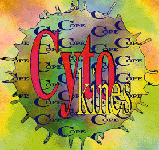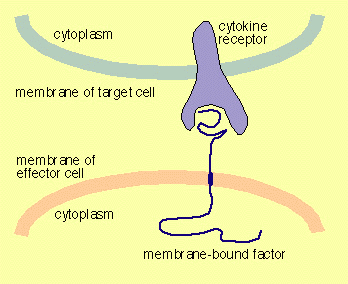
Cytokines Online Pathfinder Encyclopaedia
Horst Ibelgaufts'
Hypertext Information Universe of Cytokines
Version 4.0 (August 1999)
Attention: Please bookmark the COPE homepage.
Entry page URLs
will change with every new version
|
|
Cytokines Online Pathfinder Encyclopaedia Horst Ibelgaufts' Hypertext Information Universe of Cytokines Version 4.0 (August 1999) Attention: Please bookmark the COPE homepage. |
 |
| COPE Homepage | Previous entry: Justin Bonifacio Kapayapaan |
Next entry: K-4 |
Random entry: CT6 |
A mechanism of growth control and intercellular communication involving specific cell-to-cell contacts. These are established by the interaction of membrane-bound forms of growth factors that are normally secreted, with receptors on an adjacent cell and thus play an important role in developmental processes that have spatial restrictions. Membrane-bound forms of the growth factors then elicit the same spectrum of responses as the soluble factors. On the other hand it is known that the lack of membrane-associated forms of certain factors (for example, SCF ; kit ligand ) can have pathological consequences despite the presence of a soluble form of the same factor.
The membrane bound forms of cytokines frequently are incompletely processed biologically active precursors of the secreted form of the factor. They can be generated also by alternative splicing of the corresponding mRNA.
 |
Juxtacrine growth control has been described to be elicited, among
others, by membrane-anchored forms of AR (amphiregulin ), Betacellulin , EGF , GM-CSF , HB-EGF
(heparin-binding EGF-like growth factor), M-CSF , SCF (stem cell factor ),
SDGF (schwannoma-derived growth
factor ), VGF
, CD23 ligand,
CD27 ligand , CD40 ligand , IL1 , TGF-alpha , and TNF-alpha .
Another mechanism of juxtacrine interaction involving extracellular matrix-associated (see: ECM ) rather than membrane-anchored forms of growth factors has been described for GM-CSF , IL3 , IFN-gamma , SCI (stem cell inhibitor ), and LIF .
Since these specific interactions constitute a controlled form of cell adhesion juxtacrine interactions are involved probably in many developmental processes requiring directed and specific cell-to-cell interactions. This form of interaction allows developmentally important signals to be transmitted specifically between neighboring cells.
Juxtacrine interactions are probably also involved in the control of Hematopoiesis , allowing specific interactions between hematopoietic cells and the surrounding stromal cells (see also: LTBMC (long-term bone marrow culture ), Stromal cell line ). Experimentally this form of specific cell interactions is accessible by introduction of genes encoding specific receptors into cells that normally do not express this receptor and the subsequent detection of engineered cells adhering to the stroma.
For other mechanisms of growth control involving diffusible growth factors rather than membrane-bound forms see also: autocrine , intracrine , paracrine , retrocrine .
References: Anklesaria P et al Cell-cell adhesion mediated by binding of membrane-anchored transforming growth factor alpha to epidermal growth factor receptor promotes cell proliferation. Proceedings of the National Academy of Science (USA) 87: 3289-93 (1990); Bosenberg MW and Massagué J Juxtacrine cell signaling molecules. Current Opinion in Cell Biol. 5: 832-838 (1993); Dainiak N Cell membrane family of growth regulatory factors. Progress in Clinical and Biological Research 352: 49-61 (1990); Gordon MY et al Haemopoietic growth factors and receptors: bound and free. Cancer Cells 3: 127-33 (1991); Greenberger JS The hematopoietic microenvironment. Critical Review of Oncology and Hematology 11: 65-84 (1991); Lorant DE et al Coexpression of GMP-140 and PAF by endothelium stimulated by histamine or thrombin: a juxtracrine system for adhesion and activation of neutrophils. Journal of Cell Biology 115: 223-34 (1991); Massagué J and Pandiella A Membrane-anchored growth factors Annual Review of Biochemistry 62: 515-41 (1993); Perez C et al A non-secretable cell surface mutant of tumor necrosis factor (TNF) kills by cell-to-cell contact. Cell 63: 251-8 (1990); Pandiella A and Massagué J Cleavage of the membrane precursor for transforming growth factor alpha is a regulated process. Proceedings of the National Academy of Science (USA) 88: 1726-30 (1991); Stein J et al Direct stimulation of cells expressing receptors for macrophage colony stimulating factor (CSF-1) by a plasma membrane-bound precursor of human CSF-1. Blood 76: 1308-14 (1990); Wong ST et al The TGF-alpha precursor expressed on the cell surface binds to the EGF receptor on adjacent cells, leading to signal transduction. Cell 56: 495-506 (1989)
- K-
| # | A | B | C | D | E | F | G | H | I | J | K | L | M | N | O | P | Q | R | S | T | U | V | W | X | Y | Z |
|
COPE Developed, and maintained by Horst Ibelgaufts at the Laboratory of Molecular Biology, Gene Center, University of Munich (LMU) Presented as Jobware Programmed by BiomedAlert's CataCopia Program What others think about COPE (COPE Reviews) Correspondence with an informative subject line to: mailto:Cytokine@lmb.uni-muenchen.de |